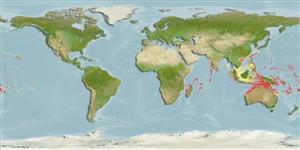>
Eupercaria/misc (Various families in series Eupercaria) >
Labridae (Wrasses)
Etymology: Labropsis: Greek, labrax, -akos = a fish, Dicentrarchus labrax + Greek,opsis = appearance (Ref. 45335).
More on author: Randall.
Environment: milieu / climate zone / depth range / distribution range
Ecologia
marinhas associadas(os) a recifes; intervalo de profundidade 0 - 55 m (Ref. 2334), usually 7 - 55 m (Ref. 27115). Tropical; 24°C - 27°C (Ref. 27115); 33°N - 24°S
Indo-Pacific: East Africa to American Samoa, north to Izu Islands, south to the Great Barrier Reef.
Tamanho / Peso / Idade
Maturity: Lm ? range ? - ? cm
Max length : 13.0 cm TL macho/indeterminado; (Ref. 2334)
Espinhos dorsais (total) : 9; Raios dorsais moles (total) : 11; Espinhos anais: 3; Raios anais moles: 10. Scales on lateral line: 46-49 (+2 past hypural) (Ref. 1602). Juveniles are black with several white pinstripes; females become lighter dorsally, and males develop golden centered scales, blue lines on the face, and a wedge-shaped white area in the center of the tail (Ref. 1602).
Uncommon inhabitant of coral-rich areas of clear outer lagoon and seaward reefs (Ref. 1602). May form small groups (Ref. 90102). Males generally solitary (Ref. 9710). Juveniles are cleaners while adults feed on coral polyps (Ref. 1602). Minimum depth reported taken from Ref. 128797.
Life cycle and mating behavior
Maturidade | Reprodução | Desova | Ovos | Fecundidade | Larvas
Oviparous, distinct pairing during breeding (Ref. 205).
Randall, J.E., G.R. Allen and R.C. Steene, 1990. Fishes of the Great Barrier Reef and Coral Sea. University of Hawaii Press, Honolulu, Hawaii. 506 p. (Ref. 2334)
Categoria na Lista Vermelha da IUCN (Ref. 130435: Version 2024-1)
Ameaça para o homem
Harmless
Utilização humana
Pescarias: espécies comerciais; Aquário: Espécies comerciais
Ferramentas
Relatórios especiais
Descarregue XML
Fontes da internet
Estimates based on models
Preferred temperature (Ref.
123201): 25.9 - 28.8, mean 27.6 °C (based on 554 cells).
Phylogenetic diversity index (Ref.
82804): PD
50 = 0.5156 [Uniqueness, from 0.5 = low to 2.0 = high].
Bayesian length-weight: a=0.00912 (0.00474 - 0.01755), b=3.06 (2.90 - 3.22), in cm total length, based on LWR estimates for this species & (Sub)family-body (Ref.
93245).
Nível Trófico (Ref.
69278): 2.9 ±0.55 se; based on food items.
Resiliência (Ref.
120179): Elevada, tempo mínimo de duplicação da população menor que 15 meses (Preliminary K or Fecundity.).
Fishing Vulnerability (Ref.
59153): Low vulnerability (10 of 100).
Nutrients (Ref.
124155): Calcium = 99.3 [57.5, 169.4] mg/100g; Iron = 0.799 [0.464, 1.460] mg/100g; Protein = 18.2 [15.3, 20.4] %; Omega3 = 0.16 [0.10, 0.25] g/100g; Selenium = 27.2 [16.7, 48.3] μg/100g; VitaminA = 132 [40, 502] μg/100g; Zinc = 1.98 [1.36, 3.23] mg/100g (wet weight);
